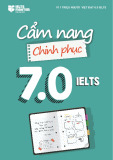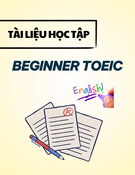
Tuyển tập Hội nghị Khoa học thường niên năm 2024. ISBN: 978-604-82-8175-5
544
USING AI IN EMI CLASSES: VOICES OF EFL TEACHERS
WHO TRANSITION TO EMI ROLES
Nguyen Thi Viet Nga
Academy of Journalism and Communication, email: nguyenthivietnga.ajc@gmail.com
1. INTRODUCTION
The adoption of English as a Medium of
Instruction (EMI) in higher education is
becoming increasingly common worldwide,
including in Vietnam. This shift aims to
enhance students' English proficiency and
better prepare them for global opportunities. As
Dearden (2014) put it, the rise of EMI is driven
by globalization and the need for English
proficiency in the international job market.
In Vietnam, the shortage of qualified EMI
teachers has necessitated the transformation of
EFL (English as a Foreign Language) teachers
into EMI instructors. EFL teachers, who
primarily focus on language skills, must now
deliver subject-specific content in English,
presenting both benefits and challenges (Doiz
et.al., 2012). On the positive side, these
teachers bring strong language instruction
skills, which can enhance students' overall
English proficiency and support their
academic success. Additionally, this transition
offers professional growth opportunities,
expanding teachers' expertise and career
prospects. However, challenges are
significant. These teachers often lack content-
specific knowledge and struggle with the dual
task of teaching complex subjects while
ensuring language comprehensibility. This
situation is exacerbated by insufficient
training and resources tailored to EMI needs,
leading to decreased confidence and
effectiveness (Nguyen et.al, 2017).
Many teachers feel inadequately prepared
for the shift, lacking specific training in EMI
methodologies. As Dang et.al. (2021) state, the
move to EMI presents a challenge to many
educators when they have to re-evaluate their
existing pedagogical approaches as they
transition to EMI. Such a transition, along with
the emergence of AI recently, forces teachers
to continue adjusting their teaching methods.
This research explores perceptions of EFL
teachers on the benefits and challenges of
using Artificial Intelligence (AI) in their EMI
classes, which will help consolidate theories
related to using AI in EMI in general and
shed better light on the situation of teaching
EMI in Vietnam.
2. RESEARCH METHOD
This qualitative research will focus on five
teachers at a mid-size university in Vietnam
who have transitioned from teaching General
English to EMI. The author gathered and
conducted an online semi-structured
interview within approximately one hour in
Vietnamese with each of these teachers (2
males, 3 females) from the same university.
All teachers have 5-15 years of experience
teaching General English for non-English
major students and have transitioned to teach
EMI for three to five years. They teach
different subjects related to five disciplines:
Linguistics, Public relations, Media studies,
Broadcasting, International Relations.
Semi-structured interviews provide depth
and detail in responses, as they allow
interviewers to probe further based on
participants' answers, thereby uncovering
rich, nuanced data (Kvale, 2007). Once the
interviews were completed, they were

Tuyển tập Hội nghị Khoa học thường niên năm 2024. ISBN: 978-604-82-8175-5
545
transcribed and translated into English for
analysis. A thematic analysis was then
employed to identify recurring themes and
patterns in the data, focusing on the teachers'
perceptions of AI's benefits and challenges in
EMI. This process involved coding the data
into categories, such as the perceived benefits
of AI and the challenges.
3. RESEARCH FINDINGS
3.1. Advantages of EFL teachers
transitioning into EMI roles when using
AI tools
EFL teachers transitioning to EMI roles
possess several unique advantages when
using AI tools to make their lessons more
comprehensible and engaging. One key
advantage is their strong foundation in
language instruction, which equips them with
the skills necessary to leverage AI tools
effectively for language support in an EMI
context. Teacher 2 said his experience in
teaching vocabulary in EMI can be enhanced
with AI applications as Grammarly,
Memrise, Quizlet… allowing for
reinforcement of language concepts. This
dual focus on language and content helps
ensure that students grasp complex subject
matter more effectively.
Furthermore, the interviewed teachers
claimed that they are good at identifying and
addressing individual student needs, a skill
that is greatly amplified by AI tools offering
personalized learning experiences. Therefore,
they use Chat GPT frequently to provide
tailored exercises, enabling them to cater to
diverse proficiency levels within the
classroom. This personalized approach not
only aids in comprehension but also fosters a
supportive learning environment where
students feel their individual challenges are
being addressed. For example, teacher 4 said
she used ChatGPT to generate customized
exercises that align with each student's current
level. “When students don’t understand a
passage, I use ChatGPT to simplify it by using
easier expressions and lower-level vocabulary.
It’s great to take just seconds to make a
passage more comprehensible”. This
adaptability ensures that students receive
relevant and appropriately challenging tasks,
fostering continuous progress. This has been
particularly beneficial when explaining
complex concepts, with one teacher stating,
"When explaining complex concepts, I always
use AI tool to help my students understand
better" (Teacher 5).
Moreover, instant translation tools support
teachers in delivering content more clearly.
For example, tools like Google Translate, or
Chat GPT can provide immediate translations,
helping students who struggle with English to
better understand the material. Teacher 5
shared that “These real-time supports ensure
that language barriers are minimized, making
lessons more accessible to all students”.
Another significant advantage is the ability
of AI tools to transform classroom dynamics
through interactive and engaging activities.
EFL teachers are often experienced in
creating engaging language lessons, and they
can extend these techniques into EMI lessons
using AI-powered applications like Kahoot!,
Quizlet or Quizziz. Teacher 1 noted,
"Incorporating AI quizzes during lessons
keeps students engaged and makes learning
fun", highlighting the effectiveness of these
interactive elements in promoting active
learning. “These tools facilitate interactive
quizzes and flashcards that make learning
more enjoyable and participatory, thereby
increasing student engagement and
motivation” (Teacher 3).
AI tools also offer substantial time-saving
benefits, which is particularly valuable for
teachers who are adapting to the increased
demands of EMI instruction. Automated
grading tools such as Grammarly or Turnitin
free up time for teachers to focus on lesson
planning and providing individualized
support. As teacher 2 remarked, “With AI
handling the grading, I can focus more on
preparing interactive lessons and providing
individual support”.

Tuyển tập Hội nghị Khoa học thường niên năm 2024. ISBN: 978-604-82-8175-5
546
3.2. Challenges of EFL teachers
transitioning into EMI roles when using
AI tools
One significant challenge is that EFL
teachers often have limited experience with AI
tools tailored for subject-specific instruction,
which can result in a considerable amount of
time and effort spent on understanding and
effectively integrating these tools into their
lessons. “Though teaching EMI, I still feel I
have been using AI tools like an EFL teacher”
(Teacher 2). “I receive no extensive training,
no professional development how to use AI
tools effectively with EMI. All I have done is
from my experience” (Teacher 3).
Moreover, the technological disruptions of
AI tools can be a concern. Technical issues,
such as software malfunctions, connection
problems, and the need for frequent updates,
can disrupt lessons and hinder the learning
process. “The Internet is not always
available, so I cannot use real-time AI tools.
Sometimes it affects the flow of my teaching”
(Teacher 5). "AI tools just don't work as
expected all the time, and it disrupts the
whole lesson plan", teacher 3 explained.
Another disadvantage is the potential for
an over-reliance on AI tools, which can
undermine the development of the teachers’
own pedagogical skills. EFL teachers may
begin to depend too heavily on AI for
delivering content and managing classroom
activities, potentially neglecting the critical
human elements of teaching, such as
fostering personal connections with students
and developing their own innovative
instructional strategies. “I worry that too
much dependence on AI might make us lose
our touch as educators" teacher 1 cautioned.
“This dependency can also lead to a lack of
confidence in our abilities to teach without
technological support” (Teacher 5).
Additionally, the cost and accessibility of
high-quality AI tools pose significant
challenges. “Some of the best AI tools are
quite expensive. My university do not provide
the financial resources for AI tools. I have to
pay if I want to use”, teacher 2 shared.
4. CONCLUSION
The findings indicate that AI tools offer
significant benefits in enhancing the
effectiveness of EMI instruction for EFL
teachers. The improved comprehension,
personalized learning, increased engagement,
and time efficiency provided by AI tools
align with previous research highlighting the
transformative potential of AI in education.
However, the challenges identified
underscore the need for better infrastructure,
training, and support to fully harness the
potential of AI in EMI contexts. Addressing
technical issues, providing adequate
professional development, and ensuring
equitable access to AI resources are crucial
steps toward maximizing the benefits of AI in
EMI instruction. Balancing the use of AI
with traditional teaching methods is also
essential to maintain pedagogical integrity
and effectiveness.
5. REFERENCES
[1] Dang, T. K. A., Bonar, G., & Yao, J. (2021).
Professional learning for educators teaching
in English-medium-instruction in higher
education: a systematic review. Teaching in
Higher Education, 28(4), 840-858.
[2] Dearden, J. (2014). English as a Medium of
Instruction-A Growing Global Phenomenon:
Phase 1. Going Global 2014, Interim
Report, Oxford: Department of Education,
University of Oxford.
[3] Doiz A., Lasagabaster D., Sierra J.M.
(2012), English-Medium Instruction at
Universities: Global Challenges.
Multilingual Matters.
[4] Kvale, S. (2007). Doing Interviews. SAGE
Publications.
[5] Nguyen, H.T., Walkinshaw, I., Pham, H.H.
(2017). EMI Programs in a Vietnamese
University: Language, Pedagogy and Policy
Issues. In: Fenton-Smith, B., Humphreys,
P., Walkinshaw, I. (eds) English Medium
Instruction in Higher Education in Asia-
Pacific. Multilingual Education, vol 21.
Springer, Cham.

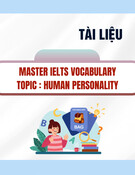

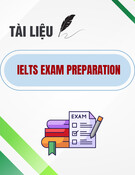






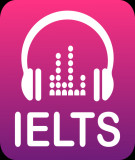
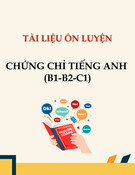
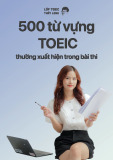
![Tài liệu luyện thi TOEIC cấp tốc trong 10 ngày [chuẩn nhất]](https://cdn.tailieu.vn/images/document/thumbnail/2025/20251029/kimphuong1001/135x160/99661761725822.jpg)
![Tài liệu Phá đảo TOEIC 900+ từ mất gốc trong 30 ngày [Mới nhất]](https://cdn.tailieu.vn/images/document/thumbnail/2025/20251029/kimphuong1001/135x160/2101761720956.jpg)





